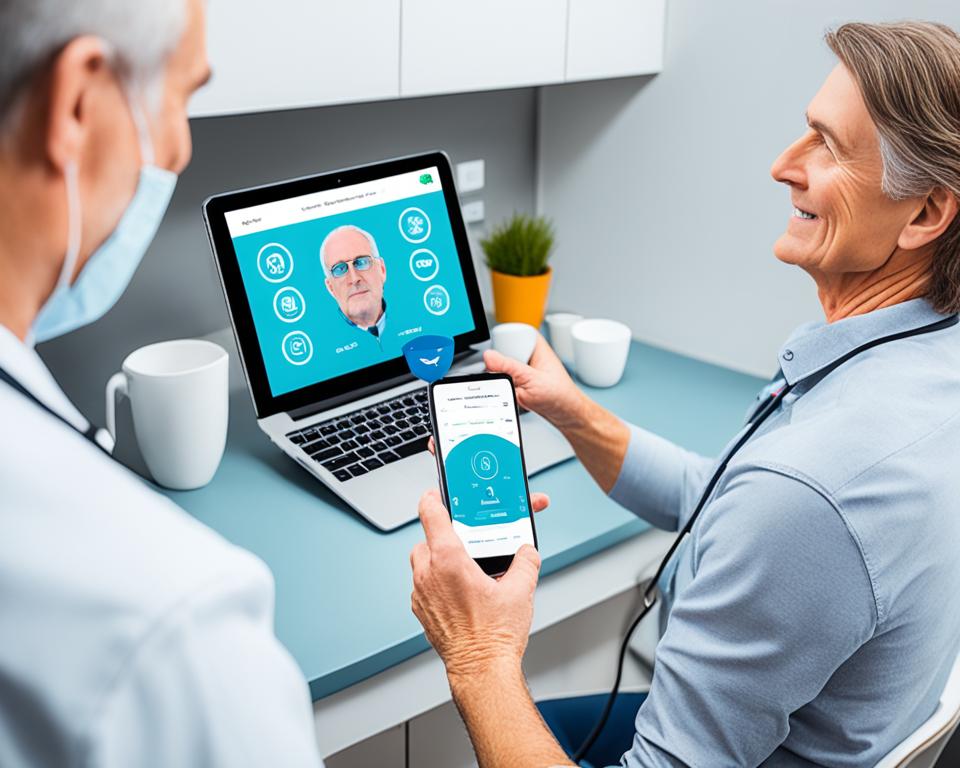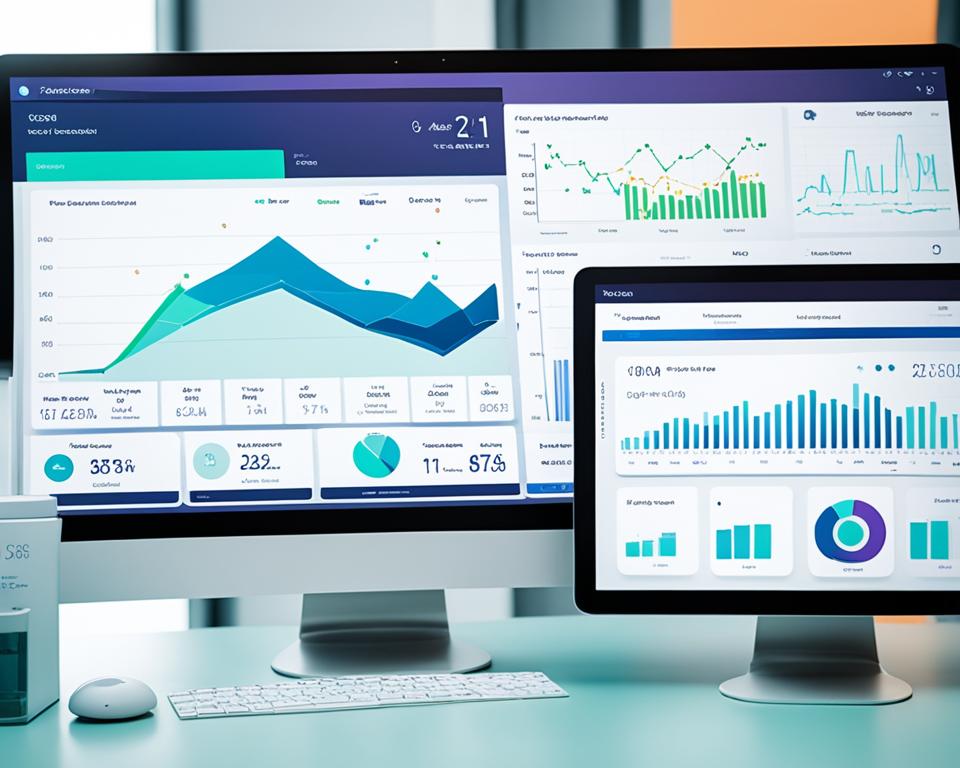Adverts
The Internet of Things (IoT) is transforming the healthcare sector, revolutionizing the patient care and bringing significant advances to medicine. The application of IoT in healthcare goes beyond fitness tracking to provide vital sign monitoring, medication management, disease diagnosis and efficient control of medical equipment.
Adverts
According to a study by Markets and Markets, the medical wearable device market is estimated to reach US$$12.1 billion in 2021, highlighting the growing importance of IoT in healthcare.
A IoT in healthcare offers a number of benefits, including remote patient monitoring, more accessible healthcare, more efficient treatments, greater diagnostic accuracy and reduced human errors. That revolution in healthcare is providing a significant improvement in the quality of life of patients and an optimization of medical services.
Main Conclusions:
- A IoT in healthcare is transforming the patient care and medicine significantly.
- The application of IoT in healthcare goes beyond fitness tracking, enabling the monitoring of vital signs, medication management and disease diagnosis.
- IoT in healthcare offers benefits such as remote patient monitoring, more accessible healthcare, more efficient treatments and greater diagnostic accuracy.
- IoT technology in healthcare also contributes to reducing human errors and improving patients' quality of life.
- The medical wearable devices market is expected to reach US$1TP4Q12.1 billion in 2021.
Benefits of IoT in Healthcare
The application of IoT in healthcare brings a series of benefits for patients and professionals in the field. Some of the key advantages include:
Adverts
- Remote patient monitoring: Doctors can monitor the health of patients remotely, using IoT devices to monitor vital signs and receive real-time updates.
- More affordable healthcare: IoT enables healthcare to be delivered more efficiently, saving time and money for patients and healthcare professionals.
- Offering the best treatment: with the help of IoT devices, healthcare professionals can gain actionable analytics and insights that help them provide personalized care and the most appropriate treatment for each patient.
- Efficient disease diagnosis: IoT in healthcare enables early detection of symptoms and preventive actions, improving diagnosis and enabling more effective treatment.
- Easy management of equipment and medicines: IoT simplifies the organized storage and inventory control of medical equipment and medicines, facilitating access and availability of necessary resources.
- Reduction of human error: with the use of IoT, the data collected and processed is more accurate, reducing the occurrence of human errors in recording and interpreting information.
- Efficient management of electronic health records: Electronic health records stored in the IoT provide quick and easy access to patients' medical history, streamlining care and improving continuity of care.
- Better insurance management: IoT facilitates continuous monitoring of patients' conditions, enabling more accurate and transparent assessment for better health insurance management.
These benefits of IoT in healthcare are transforming how professionals care for patients and how patients interact with the healthcare system. The use of IoT in medicine is driving innovation and improving the quality of medical care. The next section will address the importance of remote patient monitoring through IoT.
IoT in Remote Patient Monitoring
IoT in healthcare offers an innovative solution for remote patient monitoring, enabling continuous health monitoring without the need for frequent visits to the hospital or clinic. Across IoT devices, as smartwatches It is fitness bracelets, it is possible to collect vital data, such as heart rate, blood sugar levels and physical activity, in real time.
These smart devices are capable of transmitting accurate and up-to-date information to doctors, allowing efficient and personalized monitoring of the patient's health status. This way, healthcare professionals can identify any anomalies or fluctuations in data and take appropriate action quickly and in a timely manner.
A practical example of this remote monitoring is the use of smartwatches equipped with heart rate sensors for patients with chronic heart conditions. These devices can send automatic alerts to doctors when they detect an abnormal heart rate, enabling immediate intervention and reducing the risk of complications.
Furthermore, the data collected by IoT in remote patient monitoring They can also be shared with family members or caregivers, increasing patient safety and peace of mind. In case of emergencies or critical situations, family members can be alerted and take the necessary measures to ensure the patient's well-being.

This advanced technology remote patient monitoring Through IoT it benefits not only patients but also healthcare professionals. By having access to real-time data, doctors can make more informed and efficient decisions, providing a health monitoring more precise and personalized.
With IoT in remote patient monitoring, it is possible to improve individuals' quality of life, allowing them to continue monitoring their health even outside the clinical environment. Furthermore, this technology enables the early detection of health problems, providing more effective treatment and avoiding future complications.
Remote patient monitoring through IoT is a significant step towards a more proactive and preventive approach to healthcare, enabling continuous and timely health monitoring in a convenient and accessible way.
IoT in Medication Management
IoT in healthcare plays a crucial role in medication management, optimizing processes and improving efficiency in hospitals and clinics. With the use of IoT devices, such as minimally invasive readers and infusion pumps, it is possible to monitor and automate the medication dosage accurately and safely.
These IoT devices are capable of connecting to a control center, allowing remote medication adjustments based on each patient's specific needs. For example, in diabetic patients, IoT allows continuous control of blood glucose levels, resulting in more effective and personalized treatment.
A process automation is also a significant benefit of IoT in medication management. With IoT, it is possible to automatically schedule follow-up appointments, control medication stock and even track the availability of hospital beds.
Advantages of Medication Management with IoT:
- Greater precision in medication dosage;
- Remote medication monitoring in real time;
- Reduction of human errors in medication management;
- Process automation such as scheduling appointments and stock control;
- Improvement in operational efficiency in hospitals;
- Better control and safety in the use of medicines;
Implementing IoT in medication management brings significant benefits to patients, doctors and healthcare professionals. With advanced technologies and smart connectivity, IoT is revolutionizing the way medicines are administered, improving the safety and effectiveness of treatment.
IoT in Data Analysis and Diagnostics
IoT in healthcare enables real-time data analysis, allowing for early detection of diseases and more accurate diagnosis. Through the use of IoT devices and advanced data analysis techniques, healthcare professionals can gain valuable insights into patients' history and behavior, aiding personalized treatment and decision-making. In addition IoT in medicine also allows the use of wearable technology It is artificial intelligence, offering innovative solutions for healthcare, such as the efficient development of medicines and the improvement of research and analysis processes.
IoT in healthcare enables real-time data analysis, allowing for early detection of diseases and more accurate diagnosis.
| Real-Time Data Analysis | Accurate Diagnosis | Wearable Technology | Artificial intelligence |
|---|---|---|---|
| Through IoT, it is possible to collect real-time data and analyze them immediately, allowing you to identify health patterns and anomalies that may indicate the presence of diseases. | A real-time data analysis enables more accurate diagnosis, allowing doctors to make decisions based on up-to-date and detailed information about their patients' condition. | A wearable technology, as smartwatches and health monitoring devices, collects data that can be analyzed for trends and patterns, providing valuable information for diagnosing and preventing disease. | The use of artificial intelligence Data analysis allows us to identify complex relationships between different health factors, helping to detect diseases and predict risks in patients. |
| In real time, data is processed by algorithms that apply machine learning models and artificial intelligence to identify patterns, correlations and anomalies. | Advances in artificial intelligence algorithms enable more precise analysis of collected data, allowing subtle patterns to be identified and results to be predicted with greater reliability. | A wearable technology facilitates the collection of health data in real time, allowing you to continuously monitor a patient's condition and detect potential problems before they even manifest. | Through AI, collected data is analyzed to identify patterns and generate valuable insights to aid medical diagnosis and treatment. |
The analysis of real-time data provided by IoT in medicine is a powerful tool to offer a accurate diagnosis and assist doctors in developing personalized treatments. Wearable technology and artificial intelligence are revolutionizing medicine, enabling healthcare professionals to use real-time data to identify problems and promote better patient care.
Artificial Intelligence in Data Analysis
The application of artificial intelligence in the analysis of data collected by IoT in medicine makes it possible to identify complex patterns and relationships that go beyond human capacity. Machine learning algorithms can identify subtle correlations between different health factors, aiding in early disease detection and risk prediction. Artificial intelligence in data analysis offers valuable insights to healthcare professionals, enabling more accurate diagnosis and an individualized treatment approach.

Through real-time data analysis, IoT in medicine provides a solid foundation for making medical decisions and developing personalized treatments. Wearable technology and artificial intelligence are key elements in this process, enabling doctors to gain accurate information about their patients' health and provide more effective care. With IoT in data analysis and diagnosis, medicine is moving towards a future of more precise and personalized healthcare.
IoT Security Challenges and Solutions in Healthcare
The Internet of Things (IoT) in healthcare has brought numerous advances and benefits to improving healthcare. patient care. However, this new technology also presents significant challenges in terms of security and data privacy. With the number of connected devices increasing, it is essential to ensure protection against potential cyber threats, such as cybercriminals and privacy violations.
A IoT security in healthcare is a primary concern due to the sensitivity of patients' medical information and personal data. IoT devices, when compromised, can expose sensitive information, putting users' privacy at risk. Therefore, it is necessary to implement robust security measures to protect this valuable data.
Security Challenges:
- Protection against cybercriminals: IoT devices in healthcare can be targets for cybercriminals, who can exploit vulnerabilities and steal personal information or access sensitive medical data. It is crucial to implement security measures to prevent intrusions and attacks.
- Data privacy: Patient data privacy is a fundamental concern in healthcare. IoT in healthcare involves the collection and storage of vast amounts of personal and medical information. Ensuring the confidentiality of this data is essential to protect patient privacy.
- Data Integrity Risks: Data integrity is essential to ensure that information transmitted to and stored on IoT devices is not altered or corrupted. Ensuring data integrity is extremely important to provide appropriate treatments to patients.
Hardware Security Solutions:
To face these challenges, it is necessary to adopt hardware security solutions reliable and efficient. Thales Luna security modules are a cutting-edge solution that can be used in IoT in healthcare. These modules are designed to store and protect cryptographic keys and provide an additional layer of protection for IoT devices.
Thales Luna security modules ensure data authentication, integrity and confidentiality, helping to prevent intrusions and ensuring that only authorized users have access to data. They are specially designed to resist physical attacks and provide protection against security threats such as data tampering or device cloning.
“Thales Luna security modules ensure authentication, integrity and confidentiality of data, helping to prevent intrusions and ensuring that only authorized users have access to data.”
Furthermore, it is important to adopt “security by design” practices from the conception of IoT devices. This means that security must be considered from the beginning of the development process, integrating security measures at every stage to reduce vulnerabilities and ensure patient data is protected.
A IoT security in healthcare is essential to ensure user trust and protect the privacy of personal information. With the adoption of hardware security solutions reliability and the implementation of appropriate security practices, it is possible to address security challenges and promote the safe and efficient use of IoT in healthcare.
Implementing IoT in Medicine: Challenges and Opportunities
A implementation of IoT in medicine presents significant challenges but also offers a number of promising opportunities. For IoT in healthcare to be effectively adopted, it is necessary to face obstacles such as obtaining regulatory certifications and the device interoperability.
One of the main concerns in implementation of IoT in medicine is to ensure compliance with the regulatory certifications needed. For example, in Brazil, the National Health Surveillance Agency (Anvisa) and the National Telecommunications Agency (Anatel) establish specific requirements for IoT medical devices. Obtaining these certifications is crucial to ensuring the safety and effectiveness of devices used in healthcare.
In addition device interoperability It is a challenge that needs to be overcome. Currently, there are different proprietary and open protocols that make the integration of IoT devices difficult. Lack of standardization and compatibility between devices can limit their effectiveness and restrict their potential to improve healthcare.
However, despite the challenges, initiatives such as Open Health, promoted by the Ministry of Health, are seeking solutions for interoperability and secure sharing of health data. This type of initiative aims to establish standards and guidelines that allow the integration of IoT devices in healthcare, facilitating the exchange of information and collaboration between different systems.
A implementation of IoT in medicine offers several opportunities to improve medical care. With IoT, it is possible to facilitate communication between healthcare professionals, providing an agile exchange of information and better coordination of care. Furthermore, IoT in medicine also enables remote patient monitoring, offering personalized care and access to real-time healthcare.
Telehealth is one of the areas where IoT can bring significant benefits. Through the use of IoT devices and communication technologies, it is possible to provide medical care remotely, allowing patients to receive guidance and monitoring from their healthcare professionals without the need for physical travel.
In short, implementing IoT in medicine faces important challenges but offers transformative potential to improve healthcare. By overcoming regulatory and interoperability challenges, IoT in medicine can pave the way for more efficient, accessible and personalized care.
Conclusion
The Internet of Things (IoT) is revolutionizing patient care and the medical industry, providing a number of significant healthcare benefits. The application of IoT in healthcare enables remote patient monitoring, which allows doctors to monitor patients' health from a distance. This results in more affordable healthcare, saving time and money for both patients and healthcare professionals.
Furthermore, IoT in healthcare also facilitates the efficient diagnosis of diseases, enabling early detection of symptoms and the implementation of preventive measures. Another important benefit offered by IoT in medicine is better management of equipment and medicines, which leads to a reduction in errors and more efficient use of medical resources.
Although the implementation of IoT in medicine presents security and interoperability challenges, with the appropriate use of the technology and the adoption of security solutions such as Thales Luna security modules, it is possible to maximize the benefits and impact of IoT in healthcare . With IoT, patient care can be transformed, providing a revolution in the way healthcare is delivered and improving patients' quality of life.

 Ads The Olympics are always
Ads The Olympics are always